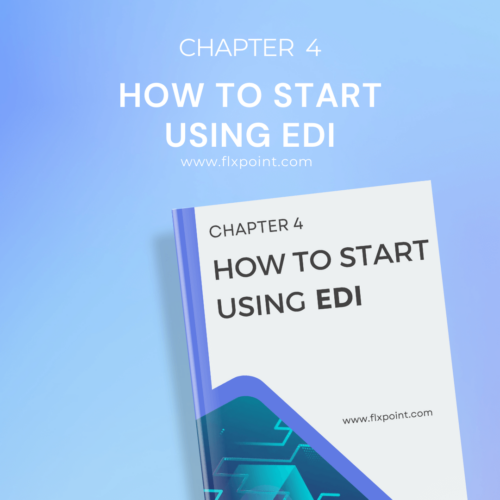Chapter 1 What is EDI?
Get to know EDI - Electronic Data Interchange. This chapter breaks down what EDI is, how it works, and why it's essential for your business.

The Ultimate Guide to EDI for Ecommerce
EDI allows businesses to exchange all important documents and information without any manual intervention. Since the exchange occurs electronically, it replaces traditional methods like paper forms, faxes, and emails with automated, secure, and standardized formats. The purpose of EDI is to simplify business operations by enabling fast, error-free communication between companies. It is widely used for processes like sending purchase orders, invoices, and shipping updates.
EDI improves efficiency, reduces costs, and fosters better collaboration among businesses. By adopting EDI, companies can streamline workflows, enhance accuracy, and stay competitive in today’s fast-paced, interconnected world.
A Simple Explanation of EDI
Electronic Data Interchange (EDI) is a system that allows businesses to exchange essential documents electronically. Instead of using paper, fax, or email, EDI automates the sharing of business information like purchase orders, invoices, and shipping details. It follows standardized formats, ensuring that the data can be easily understood and processed by computers. By using EDI, businesses save time, improve accuracy, and strengthen their communication with partners and suppliers.
How EDI Allows Businesses to Exchange Documents Digitally
- Purchase Orders – Businesses can send purchase orders directly to suppliers through EDI. This ensures orders are accurate and processed quickly.
- Invoices – Invoices sent via EDI are automatically formatted, reducing the time taken for verification and payment processing.
- Shipping Notices – EDI enables real-time updates on shipments, allowing businesses and customers to track their goods more efficiently.
- Standardized Formats – EDI uses universally accepted formats, ensuring seamless communication between different systems without manual intervention.
Elimination of Manual Processes, Reducing Errors, and Speeding Up Workflows
- Automation Benefits – EDI automates tasks like data entry and order processing, reducing the need for human involvement.
- Error Reduction – Manual processes often lead to errors such as incorrect entries or misplaced documents. EDI minimizes these mistakes by ensuring data accuracy.
- Faster Workflows – EDI speeds up the exchange of information, enabling businesses to respond quickly to orders, payments, and shipments.
- Cost Savings – By eliminating paper-based methods, businesses save on printing, mailing, and storage costs.
- Enhanced Relationships – Streamlined communication through EDI builds stronger partnerships with suppliers and customers.
How EDI Replaces Old Methods
Before the adoption of EDI, businesses relied heavily on manual processes to share information. Emails, faxes, and paper documents were common methods for exchanging data like purchase orders, invoices, and shipping details. These methods often required human intervention to create, send, and process the information, leading to inefficiencies. For example, faxed documents needed to be printed, scanned, or retyped into systems, increasing the chances of data entry errors. Paper-based processes demanded storage space and created unnecessary delays in communication. Similarly, emails, while faster than faxes, still required manual tracking and data entry, leaving room for mistakes. As business transactions became more complex, these traditional methods proved inadequate to handle the growing volume and speed requirements.
Older Methods are Not Secure Compared to EDI Systems.
Slow Processing:
- Manual handling of data in emails and paper forms causes delays.
- Faxed documents often require extra time for scanning or re-entering data.
Error-Prone:
- Human errors are common during data entry or transcription.
- Miscommunication due to illegible handwriting or missing information.
Lack of Security:
- Paper documents can be lost or intercepted.
- Email exchanges are vulnerable to cyber threats like hacking or phishing.
Limited Scalability:
- These methods struggle to keep up with high transaction volumes.
- They lack the automation needed for growing businesses.
Explain the Advantages of EDI – Automation, Accuracy, and Speed.
Automation:
- EDI automates data exchange between systems without human involvement.
- It eliminates repetitive tasks like manually sending purchase orders or invoices.
Accuracy:
- EDI reduces human errors by directly transmitting structured data.
- Information is standardized, ensuring consistency across transactions.
Speed:
- Transactions via EDI occur in real time or within seconds.
- Faster communication leads to improved order processing and delivery timelines.
Examples of EDI in Everyday Ecommerce
EDI (Electronic Data Interchange) plays a vital role in streamlining ecommerce operations by automating essential tasks like orders, invoicing, and tracking. Below are detailed examples of how EDI improves efficiency, reduces errors, and enhances customer experience in ecommerce.
Orders
- Automation – EDI automates the exchange of purchase orders (POs), allowing businesses to send and receive them electronically.
- Speed – Transactions that once took hours or days can now be completed in minutes.
- Accuracy – Automating POs reduces human errors, such as duplicate orders or incorrect product details.
- Efficiency – EDI systems directly link to inventory databases, ensuring stock levels are updated in real time.
- Scenario – A retailer orders inventory from a supplier. Using EDI, the PO is sent immediately, and the supplier processes it faster, reducing delays and ensuring accurate delivery.
Invoices
- Timely Payments – EDI streamlines invoicing by automating the generation and delivery of invoices between businesses.
- Error Reduction – EDI ensures invoice data matches the original PO, preventing billing discrepancies.
- Cost-Effective – Eliminating manual paperwork reduces processing costs for both parties.
- Scenario – A dropshipper receives an automated invoice after an order is fulfilled. The accuracy of the data ensures quick reconciliation, avoiding payment delays.
Tracking
- Real-Time Updates – EDI integrates with shipping carriers to provide real-time tracking details for orders.
- Improved Visibility – Both sellers and customers can monitor the shipment’s progress from dispatch to delivery.
- Customer Experience – Accurate tracking builds trust by keeping buyers informed.
- Scenario – An ecommerce business uses EDI to update a customer about their package’s delivery status automatically, improving satisfaction and reducing customer inquiries.
Key Benefits in Real-World Scenarios
- Order Fulfillment – Faster processing ensures products reach customers without unnecessary delays.
- Dispute Resolution – Automated invoicing minimizes disagreements over payment amounts or terms.
- Customer Trust – Real-time tracking boosts confidence in the seller’s reliability.
- Scalability – EDI supports high transaction volumes, allowing businesses to grow without operational bottlenecks.
The Role of EDI in Modern Business Transactions
Electronic Data Interchange (EDI) plays a critical role in simplifying and streamlining business processes across industries. It ensures smooth communication, reduces manual errors, and enhances operational efficiency. Let’s explore its significance in modern business transactions:
How EDI Supports Various Industries
- Retail – Retailers use EDI to manage purchase orders, invoices, and inventory updates efficiently. It ensures accurate stock levels and timely replenishment.
- Logistics – In logistics, EDI facilitates shipment tracking, delivery notifications, and customs documentation, improving supply chain transparency.
- Healthcare – EDI is vital for processing insurance claims, patient records, and medical billing. It reduces paperwork and accelerates transactions.
- Manufacturing – Manufacturers use EDI for sharing production schedules, materials orders, and shipping notices, ensuring seamless operations.
By supporting diverse industries, EDI has become an indispensable tool for managing complex business operations.
Why EDI is Crucial for Business Scalability and Competitiveness
- Efficiency Gains – EDI automates repetitive tasks, freeing up resources for strategic initiatives. This boosts productivity and reduces operational costs.
- Speed and Accuracy – Faster data exchange with minimal errors enables businesses to respond quickly to market demands and customer needs.
- Global Reach – EDI facilitates international trade by ensuring compliance with global standards and regulations, making businesses more competitive.
- Scalability – As businesses grow, EDI systems adapt to increased transaction volumes and complexity without requiring significant manual intervention.
Adopting EDI is no longer optional for businesses aiming to remain competitive in today’s fast-paced market.
Enhancing Collaboration with Suppliers, Distributors, and Partners
- Seamless Data Sharing – EDI enables real-time sharing of critical data, such as purchase orders and shipping updates, across the supply chain.
- Improved Relationships – Transparent communication fosters trust and strengthens relationships with suppliers, distributors, and other partners.
- Reduced Lead Times – Faster data exchange reduces delays, enabling quicker decision-making and better customer service.
- Error Reduction – Standardized formats minimize miscommunications, ensuring all parties work with accurate information.
EDI acts as a bridge, ensuring all stakeholders are aligned and operations run smoothly.
Conclusion
EDI is a game-changer for ecommerce and modern business operations. It simplifies processes, reduces errors, and ensures seamless communication between trading partners. By automating tasks like orders, invoices, and tracking, businesses save time and improve efficiency. EDI is crucial for scaling operations and staying competitive in today’s fast-paced markets. Adopting EDI solutions helps businesses cut costs, enhance accuracy, and boost productivity. As ecommerce grows, EDI will play an even bigger role in streamlining workflows. Businesses should embrace EDI to future-proof their operations and maintain a competitive edge in a technology-driven world.
Guide Chapters
- Chapter 1: What is EDI?
- Chapter 2: How EDI Helps Ecommerce Businesses
- Chapter 3: Everyday Uses of EDI in Ecommerce
- Chapter 4: How to Start Using EDI
- Chapter 5: Why EDI is Better Than Manual Work
- Chapter 6: EDI vs. APIs: What's the Difference?
- Chapter 7: The Future of EDI in Ecommerce
- Chapter 8: Your First Steps with EDI
- Chapter 9: EDI is the Future of Ecommerce
- Chapter 10: Quick Glossary of EDI terms
- Chapter 11: Checklist to Prepare for EDI Setup
All Chapters in This Guide

Start with the essentials. This chapter breaks down what EDI is, how it works, and why it’s a critical tool for modern ecommerce businesses. We simplify the technical jargon so you can clearly understand how EDI automates the exchange of business documents with your suppliers, warehouses, and trading partners.

Explore the powerful benefits EDI brings to your ecommerce operations. From faster communication and fewer errors to cost savings and improved accuracy, this chapter shows how EDI makes your business leaner, smarter, and more competitive.

See how EDI shows up in real day-to-day workflows. This chapter highlights common applications like order placement, shipping confirmations, inventory updates, and invoicing—so you can understand the practical ways EDI supports smooth operations.

Ready to get started? This chapter walks you through the process of adopting EDI, including evaluating your current tech stack, selecting the right partners, and integrating EDI into your existing systems. No technical background required—we make it approachable.

If you're still relying on spreadsheets, emails, or manual uploads to exchange data, this chapter is a game-changer. Learn how EDI eliminates human error, speeds up workflows, and allows your business to scale without adding more headcount.

Wondering when to use EDI or APIs? We break down the differences between these two powerful tools, when each makes the most sense, and how they can work together in a well-rounded ecommerce tech stack.

EDI is evolving rapidly. In this chapter, we explore upcoming innovations—like machine learning, tighter integrations with fulfillment partners, and greater automation. Discover how to stay ahead of the curve and be ready for what’s next.

It’s time to take action. This chapter provides a hands-on guide to assessing your business readiness, aligning with trading partners, and identifying the tools you need to implement EDI smoothly and successfully.

This isn’t just a short-term solution—it’s a long-term strategy. Learn why businesses adopting EDI today are better positioned to grow, adapt to change, and lead in a digitally connected ecommerce world.

EDI doesn’t have to be intimidating. We’ve created a glossary of key terms and acronyms to make the language of EDI more accessible, so you can communicate confidently with partners and providers.

Make sure you’re truly ready. This checklist walks through everything you’ll need to set up EDI the right way—from choosing the right platform to aligning your workflows and evaluating technical requirements. Consider this your pre-launch playbook.
Kenneth Cole's Smart Savings With Shopify EDI Connections
"They had never used Flxpoint before. But working with [the Flxpoint] team, they learned it and we're about to onboard our newest footwear partner, and you know that's big business for us.”
Mitul PatelKenneth Cole


How Flxpoint Helped Rifle Supply Automate & Grow
“I went line by line… whatever the inventory number was and cost value was, I calculated it and was blown away by how much that was worth— $300 million worth of product that I added to our web store.”
Chris MekdaraRifle Supply


The Ecommerce Automation Behind Screen Skinz
"Automation is the key to maximizing your volume. [Flxpoint] comes right into our flow — everything's automated. We want it to be quick and efficient. So that's what we love about Flxpoint."
Shaun Brown & Clay CanningScreenSkinz


How Inhaven Transformed Vendor Management with Flxpoint
"We ended up switching to Flxpoint, and it has been a much smoother process. Where it took us six months to get onboarded with the other company, we were up and running in a week or two with Flxpoint."
Ashley ChingInhaven


How Black Patch Performance Scaled Smarter with Flxpoint
"The only way to actually scale was to go through Flxpoint… You can’t even come close to hiring someone to do what Flxpoint does for the price."
Jonathan WilliamsBlack Patch Performance


